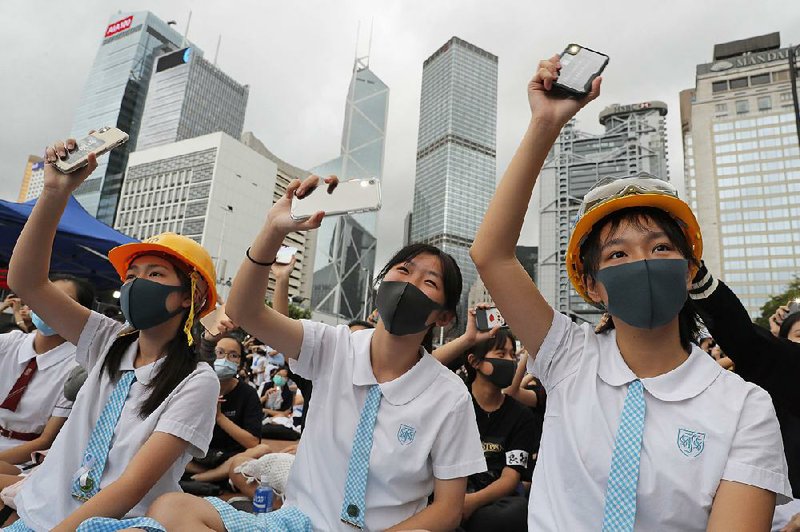HONG KONG -- Clad in gas masks along with their formal white school uniforms, tens of thousands of students in Hong Kong boycotted the first day of classes Monday as part of a citywide strike.
High school students added gas masks, goggles and hard hats to their traditional uniforms, while university pupils crowded into a square at the Chinese University of Hong Kong. Workers also participated in their own rally at a public park, braving strong winds and storm clouds as a typhoon threatened.
The strike came after a violent weekend of demonstrations that prompted a senior Hong Kong official to warn for the first time that "elements of terror" were seen among the city's pro-democracy protesters.
Hong Kong authorities had previously rejected a mainland official's description of "signs of terrorism" in characterizing acts of violence by some protesters. But John Lee, the territory's secretary for security, changed that stance Monday, as the local government escalated its criticism of the monthslong demonstrations.
"The extent of violence, danger and destruction have reached very serious conditions," Lee said. "Radical people have escalated their violent and illegal acts, showing elements of terror."
Lee cited increasing violence but offered little further explanation of how officials decided to employ the word "terror."
Monday's school boycott was the first day of a planned two-day strike.
Jacky So, president of the Chinese University of Hong Kong's student union, said 30,000 students attended a rally on campus. They dressed in black and wore face masks, waving banners for their student associations and black signs with the Chinese character for "Strike."
Separately, high school students who were skipping class rallied in Edinburgh Place, a public square in Hong Kong's central business district. Teenagers spoke to the crowd from a stage with a backdrop that read: "With no future, there's no need to go to class."
At St. Francis' Canossian College, uniformed students knelt in a line and held up hand-painted signs that read, "The five major demands: Not one is dispensable." The elite girls' school is where Hong Kong Chief Executive Carrie Lam was educated.
Hong Kong Education Secretary Kevin Yeung said he hoped students would stay in class.
"Schools should not be used as places for political demands or exercising pressure," he said at a government briefing.
The protesters' demands include dropping charges against more than 1,000 people who have been arrested and formally withdrawing an extradition bill that would allow Hong Kong residents to be sent to mainland China to stand trial. The appeals are undergirded by a sense among some Hong Kong residents that the Communist Party-ruled mainland government has been eroding the autonomy and civil liberties promised when the former British colony was returned to China in 1997.
Some demonstrators disrupted the morning commute on Monday by blocking train doors, attempting to evade riot police who were hot on their heels by moving quickly between multiple public transit stations.
Officers at Lok Fu station hit protesters with batons and arrested one. Three others were arrested at Lai King station.
Late Saturday, video from Hong Kong broadcaster TVB showed police on the platform of Prince Edward subway station swinging batons at passengers who backed into one end of a train car behind umbrellas. The video also shows pepper spray being shot through an open door at a group seated on the floor while one man holds up his hands.
Police officers said at a briefing Monday that they rejected accusations that they "beat up" ordinary citizens without first confirming their identities. They said they specifically targeted those who they believed to be rioters, including those who had changed out of their black protester outfits, and arrested 63 people on suspicion of illegal assembly and possessing explosives and offensive weapons.
Some protesters say that a degree of violence is necessary to get the government's attention after peaceful rallies were futile. Lam's administration, however, maintains that the violence must end before any fruitful dialogue can begin.
"We always say that we must stop the violence right away, and then kick off the dialogue," said Administration Secretary Matthew Cheung Kin-Chung.
Information for this article was contributed by Nadia Lam, Vincent Yu, Alice Fung, Raf Wober and Yanan Wang of The Associated Press; and by Austin Ramzy of The New York Times.
A Section on 09/03/2019
